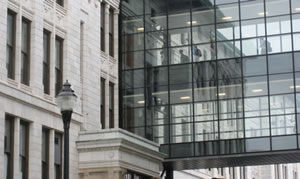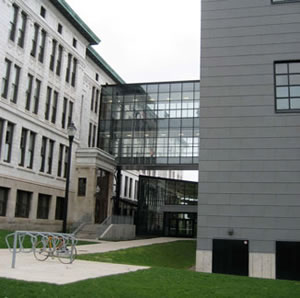New Technology in Old Buildings

PHOTOS BY SCOTT BERMAN
City Honors School in Buffalo, N.Y., is a well-lit, comfortable and typically bustling environment that at once seems old and new. Finishes and fixtures are attractive, ceilings are high and a strikingly modern extension is joined to the original Beaux Arts building by a sky bridge.
Paul McDonnell, director of Facilities, Planning Design and Construction for the Buffalo Public School District, and Conrad Wesolek, Project Executive for program provider LP Ciminelli, led School Planning & Management on a walk through this showpiece of a long-term, $1.3-billion project that has closed 15 schools in the shrinking district, and reconstructed and burnished the 48 schools that remained, including City Honors. Western New York has mountains, but perhaps none seemed as high as this project did at the outset. McDonnell and Wesolek’s pride in the work was tangible.
The project, started in 2000 and nearing completion, also has taken plenty of fortitude and determination. School officials and LP Ciminelli worked together to shepherd the project through the district and the state of New York, which, as McDonnell explains, created legislation that enabled the program provider to secure financing through bonds upfront for a 93.7-percent reimbursement by the state.
Bond interest paid for a chunk of what was left, with one of the key contractors, Johnson Controls, and the district coming up with the rest, through energy and operational performance contracts that made improvements projected to save the schools $71 million over 20 years. The district applied the savings to a range of improvements.
A key part of the initiative: concentrating a variety of technologies to create facilities that are more advanced, more secure, greener and more energy-efficient. And the high-tech features are being put in buildings that are, on average, 70 years old.
The mixture is powerful. Take for example, the recent construction of two network operation centers for the district. The centers were built into existing school buildings that were extensively renovated to accommodate them and to be powered through separate grids backed up by generators, all in order to provide secure, boosted IT throughout Buffalo’s schools.
The computing system to be housed in those centralized data centers is one of the overall project’s most important technological changes. It’s a Virtual Desktop Infrastructure (VDI) that the Buffalo district says will “allow software applications and information to be accessed from anywhere, anytime, from any device.” Students and staff’s laptop and desktop computers, tablet devices, among others, will be able to access the VDI system round-the-clock, and in turn, that system will be able to perform maintenance service to those devices remotely. LP Ciminelli, Hewlett-Packard and Buffalo-based Alternative Information systems are leading the contracting team.
The district points out that among the data centers’ and VDI’s other benefits are more computing flexibility; computer-based testing, a procedure that the state is mandating starting in the 2014-15 school year and energy savings.
Among many other steps, the overall Buffalo project has included:
- providing adequate power for electronics and computers,
- repairing and reusing ventilation systems,
- reconfiguring spaces to accommodate collaborative teaching and learning,
- making buildings ADA (Americans with Disabilities Act) accessible and
- renovating windows — an important step toward energy performance.
In other work, the district shifted from dual oil and natural gas heating to exclusively natural gas, added new boilers and electronic boiler controls, and installed air conditioning to many spaces. The biggest ticket items have been heating, ventilation and air conditioning (HVAC) systems, which Wesolek indicates made up about 14 percent of the project’s overall cost, followed by building envelope work related to energy performance.
Interestingly, each school building’s energy use has gone up by a rough average of 30 to 40 percent since renovation. It may seem counter-intuitive, until you consider how much more computing and related energy use happen in today’s schools. And with that comes greater energy efficiency in each building, and with savings achieved as a result of the district’s consolidation.
Work came in waves during technology and energy performance projects phased in over the years — in effect, running successive passes through each building to cover certain components. According to the program provider, the first two phases of the technology projects provided computer data cabling and telecommunications wiring; an expansion of that wiring and installation of interactive whiteboards.
The next technology phase brought in new security systems including motion detectors, monitoring and surveillance equipment, card readers, locking mechanisms and recordable surveillance features.
According to Johnson Controls, the company “managed the installation of about 4,000 security cameras…(as well as) large plasma monitors at each school’s main office to view security video in real time…and intelligent card systems.”
 A series of energy-performance-project phases provide, in sequence, features including temperature and lighting control systems, improvements to building envelopes and new boiler burners, major upgrades to windows, more efficiency features and a system to shut off computers during off hours, according to the program provider.
A series of energy-performance-project phases provide, in sequence, features including temperature and lighting control systems, improvements to building envelopes and new boiler burners, major upgrades to windows, more efficiency features and a system to shut off computers during off hours, according to the program provider.
There have been too many other steps to describe in full here, but a sampling of standouts is telling: equipping PS 192’s new performance hall with advanced sound and lighting systems; enclosing a courtyard at PS 67, under a fabric roof, making a striking indoor space for, among other things, a computer-aided drawing room and a cafeteria; and turning a moribund paved lot into an outdoor classroom.
Throughout, the driving impetus of sustainability is clear, and the environmental standouts include a green roof for PS 305 that will provide rainwater harvesting, an addition to PS 64 that will use aluminum sun shades, and, in particular, a series of steps at the Harriet Ross Tubman School, PS 31.
At Tubman, interesting environmental features were deployed during an early phase of the district’s renovation program. According to the program provider, this school’s comprehensive revamp included the installation of an energy-efficient white roof, the use of light shelves to draw in more ambient light, and the laying of linoleum flooring. The school’s upgraded science labs include robust, low-maintenance Trespa worktops, which according to the manufacturer are manufactured through a process that “converts softwood from certified forests into… an environmentally friendly solution.”
One of the overall results at Tubman: the U.S. Green Building Council named PS 31 as the nation’s “first K-12 pilot LEED for Existing Buildings project,” according to the program provider.
McDonnell and Wesolek note that other districts have expressed interest in the Buffalo project, and they are encouraged by the results of a major undertaking that is not just about new technology, but also about new thinking, and how both can bring older school buildings forward in a dynamic fashion.
Finally, it’s also about taking on a challenge with a keen understanding of, and vision for, your assets. As McDonnell adds, “Look, we’ve got these beautiful buildings. Let’s embrace them. And another thing, what’s more green than reusing a building?”
This article originally appeared in the School Planning & Management October 2013 issue of Spaces4Learning.